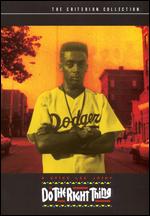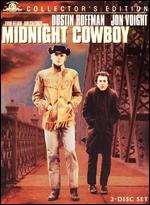 Do the Right Thing
Do the Right ThingPN1997 .D6 1990
Provoking both substantial praise and fierce criticism for its "inflammatory" content, Spike Lee's Do the Right Thing (1989) examined racism in all its complexity, eschewing simple answers for an ambiguous, artistically ambitious mosaic. The action is confined to one Brooklyn block on the hottest day of the summer, and the Bedford-Stuyvesant location thus becomes a multi-racial and multi-ethnic microcosm, spanning all ages and character types. The tapestry of incidents, whether humorous, intimate, or increasingly hostile, becomes a means to articulate a wide range of attitudes and beliefs, bolstered by cinematographer Ernest Dickerson's contrasting "hot" and "cool" colors and Lee's stylistic breaks from traditional narrative, such as direct address to the camera. Sal's Pizzeria may be the central site of confrontation, but it isn't just a matter of black vs. white. The final quotes from Malcolm X and Martin Luther King, Jr. offer differing views about racism and violence, punctuating a film that at all points questions what is the "right thing" and never offers a clear or simple answer. Funded by Universal after School Daze's success in 1988, Do the Right Thing premiered to acclaim at the Cannes Film Festival that was matched in the U.S. despite unfounded trepidation that it would provoke violence. Considered one of the few great American films made in the 1980s (although it was largely ignored by the Oscars), Do the Right Thing confirmed Lee as one of the preeminent filmmakers to emerge from the decade, while its box office success helped galvanize a new wave of 1990s African-American cinema. ~Lucia Bozzola,
All Movie Guide PN1997 .B62 2004
Mel Brooks at his ribald, tasteless best, Blazing Saddles stands out as one of the all-time great film spoofs. Sparing no one from his outrageous brand of humor, Brooks proved he was an egalitarian when it came to making fun of people, regardless of skin color or religious persuasion: where blacks may come off as stereotypical, whites are seen as just plain stupid and ignorant. Beyond its over-the-top humor and genre revision of the Western, Blazing Saddles boasts some great performances, with Madeline Kahn, Gene Wilder, and Slim Pickens doing some of the best work of their careers. It also features a number of scenes that have elevated the film into the realm of the comedy classic, perhaps most infamously the one involving beans, a campfire, and the most gratuitous display of flatulence ever to cloud a movie screen. ~Rebecca Flint Marx,
All Movie GuideWatch the trailer:
 Hoop Dreams
Hoop DreamsGV884.A1 H66 2005
The celebrated documentary from director Steve James, Hoop Dreams follows two young boys trying to take their basketball game from the inner-city streets of Chicago to the NBA. Tackling issues of racism, politics, and the dangerous power of hope, the film stands out as a complex and astute examination of the African-American experience. With the all-powerful image of Michael Jordan presiding over the film, Hoop Dreams exposes the way in which basketball has become the dominant force in the lives of so many African-American young men, who rely on their athletic skills to rise above the poverty surrounding them in a society that values only what these boys can do on the court. The film brilliantly elucidates a journey of lost innocence where the casualties of a game mean much more than simply losing on the court. ~Rachel Deahl,
All Movie GuidePN1997 .B66 1993
In the 1940s, Spencer Williams emerged as a major figure in African-American independent filmmaking. His first feature, The Blood of Jesus, is plagued by poor acting, simplistic writing, and extremely low production values that make the film look unsophisticated at best and amateurish at worst. Nevertheless, the seeds are also there for a quality film. Williams makes effective use of music, from the hymns that are present throughout much of the film to the jazz that takes over during the temptation scenes, and his handling of the jarring scene where Ras shoots Martha demonstrates his directorial skills. Finally, there is the extended sequence of Martha's odyssey through the afterlife as she is led by Satan's agents, Judas and Rufus, first to a nightclub then to a roadhouse. Williams often lingers in these places for no reason except, presumably, to soak up the scenery, indulging in some visual sinfulness under the guise of condemning this world of temptation. As much as the film has a moralistic and prudish tone, Williams' preoccupation with showing how good of a time the people are having in the nightclub and roadhouse provides an intriguing distraction; on the one hand, it serves to make the audience understand why Martha is so tempted by that world, but on the other hand, it provides Williams with the opportunity to add some welcome spice to the picture. The crime is that despite the mediocre material offered here, there is ample proof that had Williams been given access to the studio resources that plenty of lesser-talented white directors were, he would surely have left a greater mark on American film. The historical significance of The Blood of Jesus was finally recognized in 1991 when the Library of Congress placed it on its National Film Registry of American movie landmarks. ~Bob Mastrangelo,
All Movie Guide
 In the Heat of the Night
In the Heat of the NightPN1997 .I5 1983
Norman Jewison's In The Heat of the Night was one of the unlikeliest hits to come out of 1967. Few issues were more provocative or dangerous to discuss in private, much less on screen, than race relations in the United States, and that went double for the Deep South, where the movie (based on John Ball's book) was set. Additionally, the country didn't seem to be clamoring for that kind of discussion: to this day, Roger Corman's The Intruder (1961) is the only theatrical film ever made about school integration in the South. Jewison defied every piece of industry wisdom and won out, mostly because he played it straight and honest, with a cast led by two actors who could hardly have been improved upon for the parts they played. The thematic set-up was surprisingly similar to The Defiant Ones, in which Poitier had co-starred for Stanley Kramer nine years earlier, but the directorial touch was smoother and the film was filled with an enviable range of wonderful supporting performances. In The Heat of the Night was successful enough to generate a brace of films that tried for the same mix of topicality and drama (as well as two sequels, They Call Me Mister Tibbs and The Organization that were more action-oriented), among them William Wyler's The Liberation of L.B. Jones (which came from the same screenwriter), Lamont Johnson's made-for-television My Sweet Charlie, and Ralph Nelson's Tick Tick Tick, all of which opened race relations to more honest and straightforward cinematic exploration. ~Bruce Eder,
All Movie GuideWatch the trailer:

In conjunction with documentary filmmaker Ken Burns' ten-part 2000 PBS special, Columbia/Legacy and Verve teamed up to issue a special series of reissues covering much of the history of 20th century jazz. The central release of this program is the five-CD box set Ken Burns Jazz: The Story of America's Music, its 94 selections covering the history of 20th century jazz, from 1917 to the mid-'90s. Chronologically, the set is very skewed toward the first 50 years of that time span; there is only just under a CD's worth of music dating from after the mid-'60s. What's here is a very good range of classic jazz from throughout the decades, touching upon performances, many acknowledged classics, from many of the music's giants: Louis Armstrong, Duke Ellington, Benny Goodman, Billie Holiday, Dizzy Gillespie, Charlie Parker, Thelonious Monk, John Coltrane, Miles Davis, Ornette Coleman, and up to Wynton Marsalis and Cassandra Wilson. There are just a few dubious inclusions (Grover Washington, Jr.'s "Mister Magic," for instance), and as music it's nearly wall-to-wall excellence. As far as core classics of the jazz repertoire, there are quite a few: Armstrong's "West End Blues," Goodman's "Sing, Sing, Sing (With a Swing)," Count Basie's "Lester Leaps In," Holiday's "Strange Fruit," Ellington's "Take the 'A' Train," Gillespie's "Salt Peanuts," Monk's "Straight, No Chaser," Davis' "So What," Dave Brubeck's "Take Five," Coltrane's "Giant Steps," Weather Report's "Birdland," and Hancock's "Rockit." As education, if you didn't know much about jazz before hearing this box, you'll have been exposed to a good deal of its major touchstones after digesting it. Just don't be under the impression that it covers all of the main mileposts, or even that it gives you all of the key launching pads from which to explore further. ~Richie Unterberger,
All Music Guide
 Do the Right Thing
Do the Right Thing Hoop Dreams
Hoop Dreams In the Heat of the Night
In the Heat of the Night






